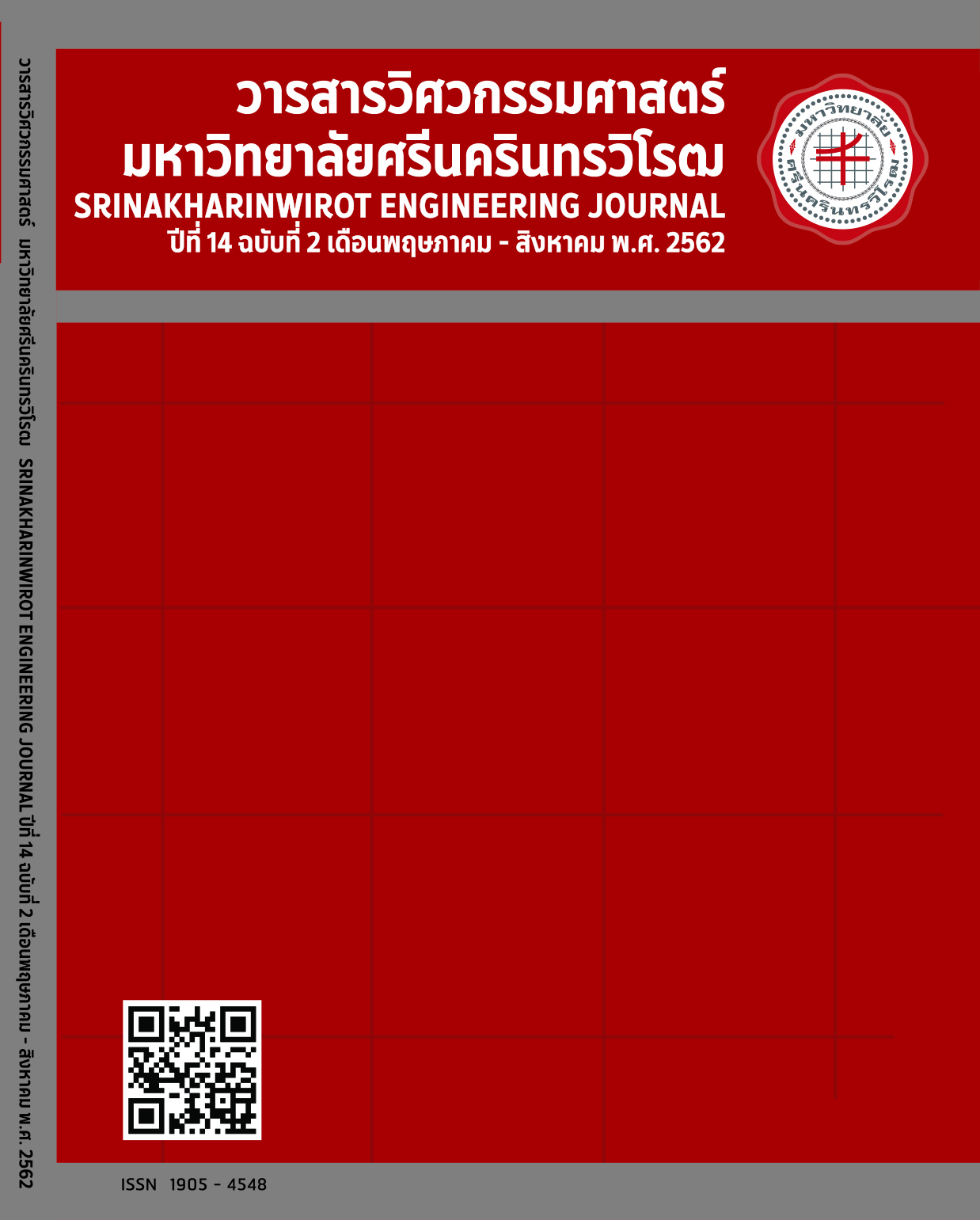การศึกษาถึงพฤติกรรมการไหลและการถ่ายเทความร้อนในฮีทซิงค์สำหรับชุดโมดูลการทำความเย็นด้วยเทอร์โมอิเล็กตริกด้วยระเบียบวิธีพลศาสตร์ของไหลเชิงคำนวณ
Main Article Content
บทคัดย่อ
งานวิจัยนี้เป็นการวิเคราะห์ถึงคุณลักษณะการถ่ายเทความร้อนของชุดครีบระบายความร้อนที่มีลักษณะของช่องการไหลต่างกันที่ใช้ร่วมกับเทอร์โมอิเล็กตริกสำหรับระบายความร้อนให้กับอุปกรณ์อิเล็กทรอนิกส์โดยใช้ระเบียบวิธีพลศาสตร์ของไหลเชิงคำนวน (CFD) รูปแบบของชุดครีบระบายความร้อนที่ใช้ในการวิเคราะห์ลักษณะการไหลและการถ่ายเทความร้อน สมการหลักที่ใช้ในการแก้ปัญหาประกอบไปด้วย สมการความต่อเนื่อง สมการโมเมนตัม และสมการพลังงานซึ่งใช้ในการวิเคราะห์ลักษณะการไหลของของไหลและการถ่ายเทความร้อน จากผลการศึกษาพบว่าลักษณะของช่องการไหลภายในชุดครีบระบายความร้อนที่มีขนาดเล็กและจำนวนครีบมากกว่าทำให้มีพื้นที่การถ่ายเทความร้อนที่มากกว่า ส่งผลให้มีประสิทธิภาพการถ่ายเทความร้อนได้ดียิ่งขึ้น แต่อย่างไรก็ตามจะพบว่าผลของความเร็วมีค่าลดลงขณะที่ความดันตกคร่อมมีค่าสูงขึ้น จากผลการศึกษานี้สามารถนำไปเป็นต้นแบบในการวิเคราะห์ชุดครีบเพื่อใช้ในการผลิตน้ำเย็นเพื่อนำไปใช้ในระบบระบายความร้อนให้กับอุปกรณ์อิเล็กทรอนิกส์ได้อิเล็กทรอนิกส์ได้
Article Details
ลิขสิทธิ์เป็นของวารสารวิศวกรรมศาสตร์ มหาวิทยาลัยศรีนครินทรวิโรฒ
References
[2] P. Naphon and S. Wiriyasart, “Liquid cooling in the mini-rectangular fin heat sink with and without thermoelectric for CPU,” International Communications in Heat and Mass Transfer, vol. 36, pp. 166-171, 2009.
[3] H.-S. Huang, Y.-C. Weng, Y.-W. Chang, S.-L. Chen, M.-T. Ke, “Thermoelectric water-cooling device applied to electronic equipment,” International Communications in Heat and Mass Transfer, vol. 37, pp. 140-146, 2010.
[4] Y. Zhou and J. Yu, “Design optimization of thermoelectric cooling systems for applications in electronic devices,” International Journal of Refrigeration, vol. 35, pp. 1139-1144, 2012.
[5] L. Zhu, H. Tan, J. Yu, “Analysis on optimal heat exchanger size of thermoelectric cooler for electronic cooling applications,” Energy Conversion and Management, vol. 76, pp. 685-690, 2013.
[6] D. Liu, F.-Y. Zhao, H.-X. Yang, G.-F. Tang, “Thermoelectric mini cooler coupled with micro thermosiphon for CPU cooling system,” Energy, vol. 83, pp. 29-36, 2015.
[7] R. Nebbati and M. Kadja, “Study of Forced Convection of a Nanofluid Used as a Heat Carrier in a Microchannel Heat Sink,” Energy Procedia, vol. 74, pp. 633-642, 2015.
[8] S. Wiriyasart and P. Naphon, “Study on Liquid Jet Impingement Heat Transfer and Flow Behaviors of the Vapor Chambers with and without Mini-channel,” in Conference of Mechanical Engineering Network of Thailand., Nakhon Nayok., 2017.
[9] S. Wiriyasart and P. Naphon, “Thermal Cooling of Electronic Devices with Cold Plate Using Liquid as Coolant,” in Conference of Mechanical Engineering Network of Thailand., Nakhon Nayok., 2017.
[10] Y. Wang, Y. Shi, D. Liu, “Performance analysis and experimental study on thermoelectric cooling system coupling with heat pipe,” Procedia Engineering, vol. 205, pp. 871-878, 2017.
[11] Y. M. Seo et al., “A numerical study on the performance of the thermoelectric module with different heat sink shapes,” Applied Thermal Engineering, vol. 128, pp. 1082-1094, 2018.
[12] S. Wiriyasart and P. Naphon, “Study on thermal performance of cold plate unit with micro-channel for supercomputer cooling,” JP Journal of Heat and Mass Transfer, vol. 15, pp. 77-92, 2018.

